Qin Huang
C2AL: Cohort-Contrastive Auxiliary Learning for Large-scale Recommendation Systems
Oct 02, 2025Abstract:Training large-scale recommendation models under a single global objective implicitly assumes homogeneity across user populations. However, real-world data are composites of heterogeneous cohorts with distinct conditional distributions. As models increase in scale and complexity and as more data is used for training, they become dominated by central distribution patterns, neglecting head and tail regions. This imbalance limits the model's learning ability and can result in inactive attention weights or dead neurons. In this paper, we reveal how the attention mechanism can play a key role in factorization machines for shared embedding selection, and propose to address this challenge by analyzing the substructures in the dataset and exposing those with strong distributional contrast through auxiliary learning. Unlike previous research, which heuristically applies weighted labels or multi-task heads to mitigate such biases, we leverage partially conflicting auxiliary labels to regularize the shared representation. This approach customizes the learning process of attention layers to preserve mutual information with minority cohorts while improving global performance. We evaluated C2AL on massive production datasets with billions of data points each for six SOTA models. Experiments show that the factorization machine is able to capture fine-grained user-ad interactions using the proposed method, achieving up to a 0.16% reduction in normalized entropy overall and delivering gains exceeding 0.30% on targeted minority cohorts.
External Large Foundation Model: How to Efficiently Serve Trillions of Parameters for Online Ads Recommendation
Feb 26, 2025



Abstract:Ads recommendation is a prominent service of online advertising systems and has been actively studied. Recent studies indicate that scaling-up and advanced design of the recommendation model can bring significant performance improvement. However, with a larger model scale, such prior studies have a significantly increasing gap from industry as they often neglect two fundamental challenges in industrial-scale applications. First, training and inference budgets are restricted for the model to be served, exceeding which may incur latency and impair user experience. Second, large-volume data arrive in a streaming mode with data distributions dynamically shifting, as new users/ads join and existing users/ads leave the system. We propose the External Large Foundation Model (ExFM) framework to address the overlooked challenges. Specifically, we develop external distillation and a data augmentation system (DAS) to control the computational cost of training/inference while maintaining high performance. We design the teacher in a way like a foundation model (FM) that can serve multiple students as vertical models (VMs) to amortize its building cost. We propose Auxiliary Head and Student Adapter to mitigate the data distribution gap between FM and VMs caused by the streaming data issue. Comprehensive experiments on internal industrial-scale applications and public datasets demonstrate significant performance gain by ExFM.
An Integrated Sensing and Communications System Based on Affine Frequency Division Multiplexing
Jan 31, 2025Abstract:This paper proposes an integrated sensing and communications (ISAC) system based on affine frequency division multiplexing (AFDM) waveform. To this end, a metric set is designed according to not only the maximum tolerable delay/Doppler, but also the weighted spectral efficiency as well as the outage/error probability of sensing and communications. This enables the analytical investigation of the performance trade-offs of AFDM-ISAC system using the derived analytical relation among metrics and AFDM waveform parameters. Moreover, by revealing that delay and the integral/fractional parts of normalized Doppler can be decoupled in the affine Fourier transform-Doppler domain, an efficient estimation method is proposed for our AFDM-ISAC system, whose unambiguous Doppler can break through the limitation of subcarrier spacing. Theoretical analyses and numerical results verify that our proposed AFDM-ISAC system may significantly enlarge unambiguous delay/Doppler while possessing good spectral efficiency and peak-to-sidelobe level ratio in high-mobility scenarios.
Multi-Satellite Cooperative Networks: Joint Hybrid Beamforming and User Scheduling Design
Oct 12, 2023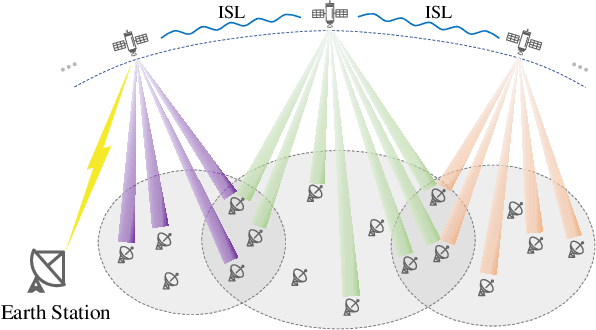

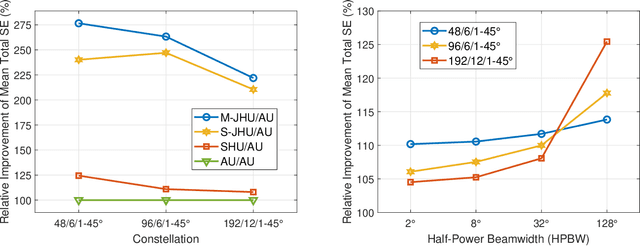
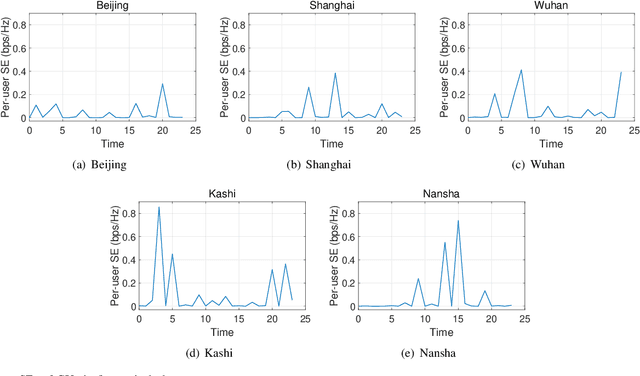
Abstract:In this paper, we consider a cooperative communication network where multiple low-Earth-orbit satellites provide services for ground users (GUs) (at the same time and on the same frequency). The multi-satellite cooperative network has great potential for satellite communications due to its dense configuration, extensive coverage, and large spectral efficiency. However, the communication and computational resources on satellites are usually restricted. Therefore, considering the limitation of the on-board radio-frequency chains of satellites, we first propose a hybrid beamforming method consisting of analog beamforming for beam alignment and digital beamforming for interference mitigation. Then, to establish appropriate connections between the satellites and GUs, we propose a low-complexity heuristic user scheduling algorithm which determines the connections according to the total spectral efficiency increment of the multi-satellite cooperative network. Next, considering the intrinsic connection between beamforming and user scheduling, a joint hybrid beamforming and user scheduling (JHU) scheme is proposed to dramatically improve the performance of the multi-satellite cooperative network. In addition to the single-connection scenario, we also consider the multi-connection case using the JHU scheme. Moreover, simulations are conducted to compare the proposed schemes with representative baselines and to analyze the key factors influencing the performance of the multi-satellite cooperative network.
Towards the Better Ranking Consistency: A Multi-task Learning Framework for Early Stage Ads Ranking
Jul 12, 2023



Abstract:Dividing ads ranking system into retrieval, early, and final stages is a common practice in large scale ads recommendation to balance the efficiency and accuracy. The early stage ranking often uses efficient models to generate candidates out of a set of retrieved ads. The candidates are then fed into a more computationally intensive but accurate final stage ranking system to produce the final ads recommendation. As the early and final stage ranking use different features and model architectures because of system constraints, a serious ranking consistency issue arises where the early stage has a low ads recall, i.e., top ads in the final stage are ranked low in the early stage. In order to pass better ads from the early to the final stage ranking, we propose a multi-task learning framework for early stage ranking to capture multiple final stage ranking components (i.e. ads clicks and ads quality events) and their task relations. With our multi-task learning framework, we can not only achieve serving cost saving from the model consolidation, but also improve the ads recall and ranking consistency. In the online A/B testing, our framework achieves significantly higher click-through rate (CTR), conversion rate (CVR), total value and better ads-quality (e.g. reduced ads cross-out rate) in a large scale industrial ads ranking system.
Joint Hybrid Beamforming and User Scheduling for Multi-Satellite Cooperative Networks
Jan 13, 2023



Abstract:In this paper, we consider a cooperative communication network where multiple satellites provide services for ground users (GUs) (at the same time and on the same frequency). The communication and computational resources on satellites are usually restricted and the satellite-GU link determination affects the communication performance significantly when multiple satellites provide services for multiple GUs in a collaborative manner. Therefore, considering the limitation of the on-board radio-frequency chains, we first propose a hybrid beamforming method consisting of analog beamforming for beam alignment and digital beamforming for interference mitigation. Then, to establish appropriate connections between satellites and GUs, we propose a heuristic user scheduling algorithm which determines the connections according to the total spectral efficiency (SE) increment of the multi-satellite cooperative network. Next, a joint hybrid beamforming and user scheduling scheme is proposed to dramatically improve the performance of the multi-satellite cooperative network. Moreover, simulations are conducted to compare the proposed schemes with representative baselines and analyze the key factors influencing the performance of the multi-satellite cooperative network. It is shown that the proposed joint beamforming and user scheduling approach can provide 47.2% SE improvement on average as compared with its non-joint counterpart.
An AFDM-Based Integrated Sensing and Communications
Aug 29, 2022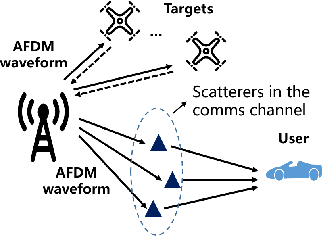
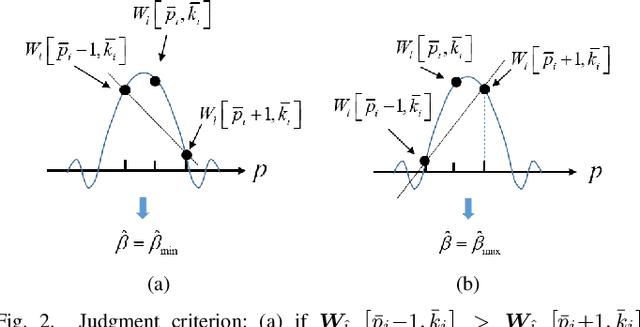
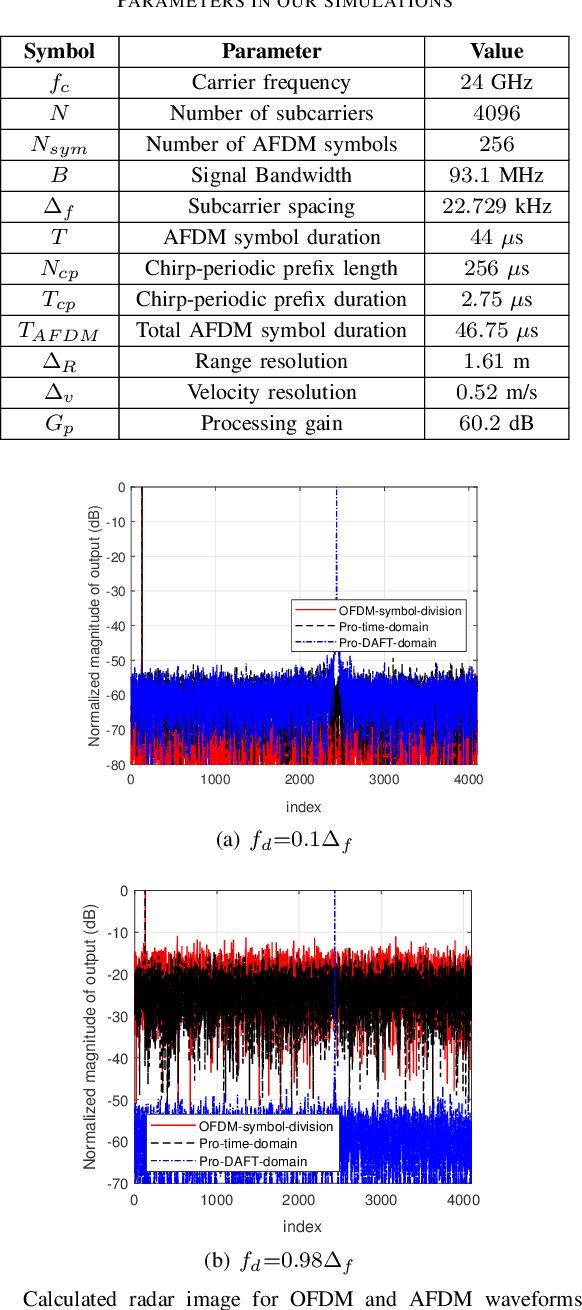
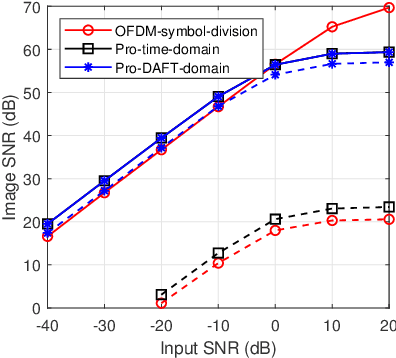
Abstract:This paper considers an affine frequency division multiplexing (AFDM)-based integrated sensing and communications (ISAC) system, where the AFDM waveform is used to simultaneously carry communications information and sense targets. To realize AFDM-based sensing functionality, two parameter estimation methods are designed to process echoes in the time domain and the discrete affine Fourier transform (DAFT) domain, respectively. It allows us to decouple delay and Doppler shift in the fast time axis and can maintain good sensing performance even in large Doppler shift scenarios. Numerical results verify the effectiveness of our proposed AFDM-based system in high mobility scenarios.
Optimization of Forcemyography Sensor Placement for Arm Movement Recognition
Jul 22, 2022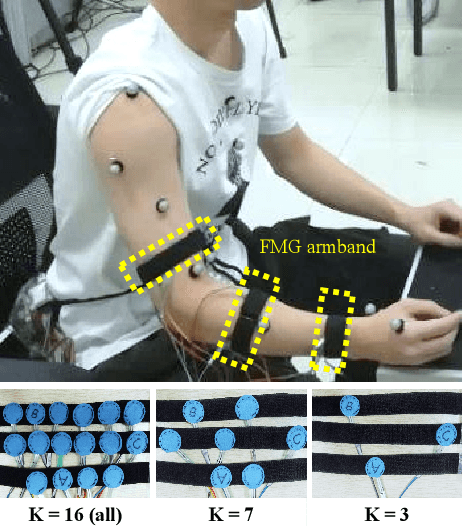


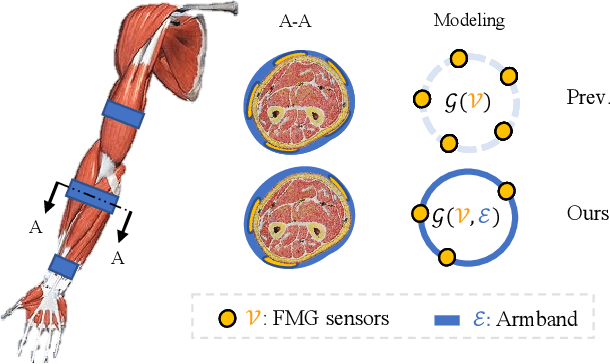
Abstract:How to design an optimal wearable device for human movement recognition is vital to reliable and accurate human-machine collaboration. Previous works mainly fabricate wearable devices heuristically. Instead, this paper raises an academic question: can we design an optimization algorithm to optimize the fabrication of wearable devices such as figuring out the best sensor arrangement automatically? Specifically, this work focuses on optimizing the placement of Forcemyography (FMG) sensors for FMG armbands in the application of arm movement recognition. Firstly, based on graph theory, the armband is modeled considering sensors' signals and connectivity. Then, a Graph-based Armband Modeling Network (GAM-Net) is introduced for arm movement recognition. Afterward, the sensor placement optimization for FMG armbands is formulated and an optimization algorithm with greedy local search is proposed. To study the effectiveness of our optimization algorithm, a dataset for mechanical maintenance tasks using FMG armbands with 16 sensors is collected. Our experiments show that using only 4 sensors optimized with our algorithm can help maintain a comparable recognition accuracy to using all sensors. Finally, the optimized sensor placement result is verified from a physiological view. This work would like to shed light on the automatic fabrication of wearable devices considering downstream tasks, such as human biological signal collection and movement recognition. Our code and dataset are available at https://github.com/JerryX1110/IROS22-FMG-Sensor-Optimization
Unsupervised Video Object Segmentation with Distractor-Aware Online Adaptation
Dec 19, 2018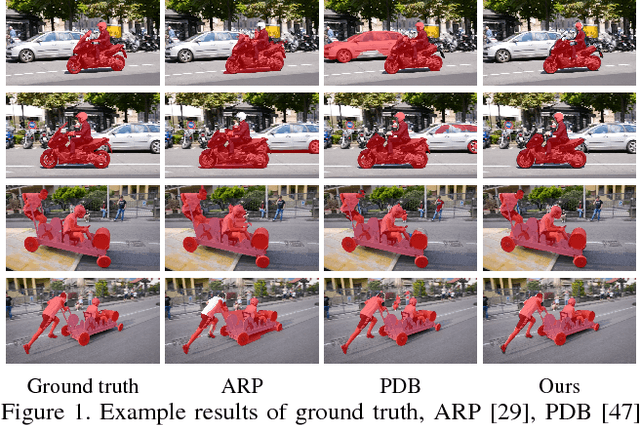

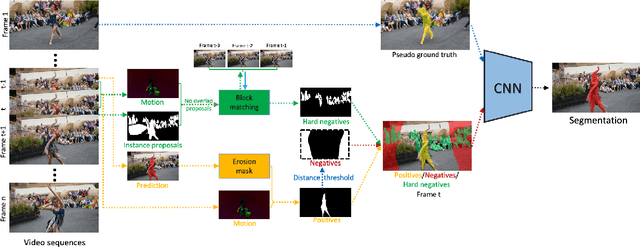

Abstract:Unsupervised video object segmentation is a crucial application in video analysis without knowing any prior information about the objects. It becomes tremendously challenging when multiple objects occur and interact in a given video clip. In this paper, a novel unsupervised video object segmentation approach via distractor-aware online adaptation (DOA) is proposed. DOA models spatial-temporal consistency in video sequences by capturing background dependencies from adjacent frames. Instance proposals are generated by the instance segmentation network for each frame and then selected by motion information as hard negatives if they exist and positives. To adopt high-quality hard negatives, the block matching algorithm is then applied to preceding frames to track the associated hard negatives. General negatives are also introduced in case that there are no hard negatives in the sequence and experiments demonstrate both kinds of negatives (distractors) are complementary. Finally, we conduct DOA using the positive, negative, and hard negative masks to update the foreground/background segmentation. The proposed approach achieves state-of-the-art results on two benchmark datasets, DAVIS 2016 and FBMS-59 datasets.
Design Pseudo Ground Truth with Motion Cue for Unsupervised Video Object Segmentation
Dec 13, 2018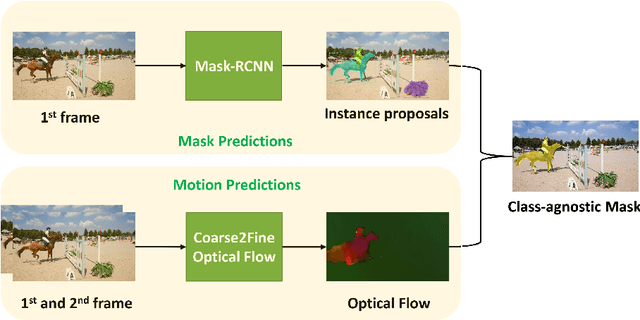


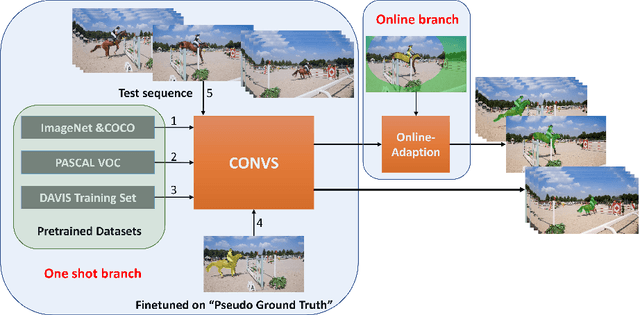
Abstract:One major technique debt in video object segmentation is to label the object masks for training instances. As a result, we propose to prepare inexpensive, yet high quality pseudo ground truth corrected with motion cue for video object segmentation training. Our method conducts semantic segmentation using instance segmentation networks and, then, selects the segmented object of interest as the pseudo ground truth based on the motion information. Afterwards, the pseudo ground truth is exploited to finetune the pretrained objectness network to facilitate object segmentation in the remaining frames of the video. We show that the pseudo ground truth could effectively improve the segmentation performance. This straightforward unsupervised video object segmentation method is more efficient than existing methods. Experimental results on DAVIS and FBMS show that the proposed method outperforms state-of-the-art unsupervised segmentation methods on various benchmark datasets. And the category-agnostic pseudo ground truth has great potential to extend to multiple arbitrary object tracking.
 Add to Chrome
Add to Chrome Add to Firefox
Add to Firefox Add to Edge
Add to Edge